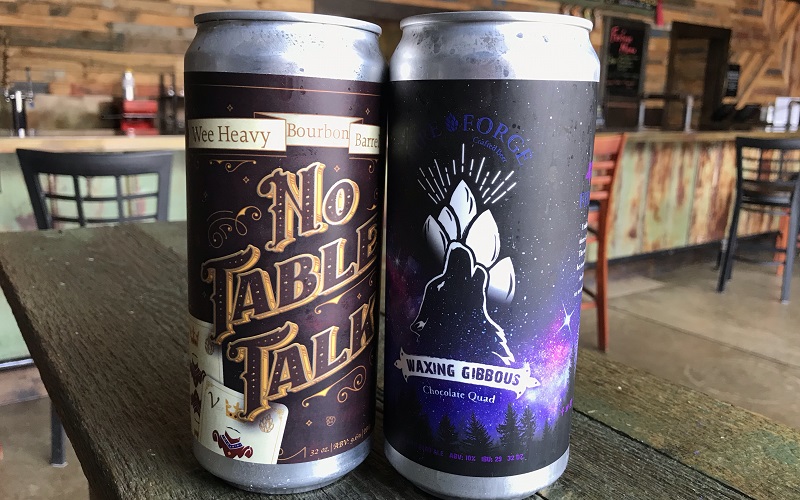We’ve all heard that good wine gets better with age, and we’ve seen hyped crowds line up for rare, aged whiskeys. But does beer stand the test of time?
99% of craft beers are intended to be consumed as fresh as possible. But there are a few that may be improved with age, and many craft drinkers have taken up the art of cellaring beer.
Aging your favorite beers—or cellaring—is the delicate process of keeping the most appropriate styles in a dark space with low humidity and consistent temperatures (ideally 50-55°). Beers need to be kept upright so that yeast sediment can remain at the bottom and the liquid makes minimal contact with the cork or cap (if bottled). And every cellaring enthusiast needs a hefty round of patience to let his or her beloved barrel-aged stout sit quietly for six months, a year or perhaps longer.
Will the Beer Go Bad?
This is a common and valid concern, it’s important to define the phrase “go bad.” An aged beer will not turn into a sludge of mold that will make you ill, like the leftovers you accidentally aged a few weeks in the back of your fridge.
Instead, the concern for beer “going bad” is that it will lose the quality flavor and aroma the brewer intended for you to enjoy. For example, a beer left for an extended time near sunlight will become “light struck” and taste skunky (remember that old Heinekin in the green bottle that you drank after it had been on the counter for a few months?). Beer that isn’t sealed in a 100% air-tight container—such as a growler or bottle that lets air seep through the cap—will become oxidized with time and taste like cardboard.
Neither of these examples will make you ill, but your spirit will be sick with grief that your aged brew doesn’t taste as amazing as when you drank it fresh.
What Beers Age Best?
The first step to successfully aging beer is to choose the ideal style. Nearly all brewers release a beer when it is at its peak and want it to be consumed fresh. Over time, the keynote flavors and aromas of hops, fruit, or adjuncts like coffee and vanilla can decrease, change, or even disappear from the beer.
For that reason, the best styles to cellar should hit these notes:
- Higher ABV
- Full-bodied, maltier body
- Barrel-aged
- Fewer adjuncts
- Wild-fermented beers
Beers that hit these points can be hidden in a cool cupboard for months or years for a special opening occasion. Adjuncts, or the additional items you add to a beer for flavor such as fruits, spices and herbs, tend to fall out over time. In the case of wild-fermented beers, the wild yeast or bacteria used in fermentation is often still present in the beer and can continue to change the beer’s characteristics. Part of the joy of aging beers is seeing how they transform over time.
Some Fireforge Beer Recommendations
In my experience, a barrel-aged scotch ale like our No Table Talk Wee Heavy may take on a boozier flavor after sitting for a few months. You will likely detect more wood and vanilla notes from the Woodford Reserve barrels we aged the beer in for three months.
Another good beer for aging is our Waxing Gibbous Belgian Chocolate Quad. The high ABV helps preserve the beer, and the maltier body will stand up better over time compared to a lighter, crisper beer. It is unfiltered (like all of our beers) and the Belgian yeast strain will continue a remarkable transformation in the beer over time. The spicy phenols often soften to flavors of vanilla and leather, while the fruity esters evolve into dried and dark fruit flavors. The chocolate flavor may not remain at the same level it is right now, but the roasted grain should still provide a chocolate-like experience after aging.
Both beers are also already canned in an air-tight crowler. While we normally recommend consuming crowlers within 2-3 weeks, these sealed containers are known for holding up much longer because they do not allow air or light to affect the beer. I recently opened a four-month old crowler of our Rhombus Belgian Quad and wow! It was remarkably smooth after hanging out in my cellar, with a softer, less peppery finish.
But I Really Want to Age This IPA…
If you have your heart set on aging a beer that doesn’t fit the above characteristics, such as a pilsner or IPA, then you can do it for science’s sake. But be prepared for an end result that may be drinkable but not ideal.
In the case of lighter beers or beers with a lot of hops and adjuncts, store them upright in your refrigerator. Ideally, they should be placed on a lower shelf where there will be consistent temperatures (not too far back where the fridge is colder and not in the door where the temperature fluctuates).
You can expect all aged beers to change in mouthfeel as the body thins over time. In particular, the wheat protein found in wheat styles like hefeweizens and witbiers falls out quickly and creates a thinner, drier body.
An aggressively hopped IPA will experience diminishing hop flavor almost immediately. While an IPA might still taste good a month or two after bottling, don’t expect to find your favorite hop flavor and aroma a year later. Pastry stouts and milkshake IPAs with various adjuncts, such as fruits, vanilla and lactose, will also lose flavors, resulting in a blander beer than the brewer intended.
Do you have a private cellar at home? What have been your favorite beer cellaring successes and failures?

